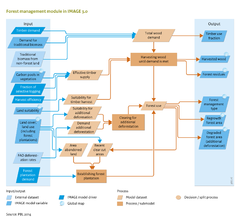Forest management/Policy issues: Difference between revisions
Jump to navigation
Jump to search
m (Text replace - "|Status=Publishable" to "") |
No edit summary |
||
| Line 1: | Line 1: | ||
{{ComponentPolicyIssueTemplate | {{ComponentPolicyIssueTemplate | ||
|Description=The forest management model of IMAGE has been used for the scenario study ‘Rethinking global biodiversity strategies’ on future biodiversity developments (Ten Brink et al., 2010). The study projects that, in the absence of additional forestry policy, the area of forest plantations will increase slightly between 2000 and 2050 (from 1.1 to 1.2 million km2). At the same time, the total forest area used in wood production will increase from 9.5 to 14.5 million km2 (Figure 4.2.2.1, left panel). According to this projection, by 2050, just over a third of the global forest area will be used for the production of wood, and the area of primary forest, as a consequence, will have decreased by more than 6 million km2 from almost 30 million km2 in 2000. | |||
|Example=With respect to forest management, several policy interventions can be simulated in the IMAGE model 3.0. These include: | |||
• an increase in the area of highly productive forest plantations; | |||
• an increase in carbon storage to mitigate climate change; | |||
• a larger share of produced wood from reduced impact logging (RIL) techniques instead of conventional selective felling. | |||
=== RIL === | |||
Regarding this last point, in the scenario study ‘Rethinking global biodiversity strategies’, the following two different ambition levels for introducing improved forest management were implemented, analysed, and compared to a baseline scenario (Figures 4.2.2.2 and 4.2.2.3): | |||
1. a moderate ambition level, with partial substitution of conventional selective felling in tropical forests, using RIL techniques, and forest plantations targeted at supplying 25% of the global wood demand; | |||
2. a high ambition level, with full substitution of conventional selective felling for RIL techniques as of 2010, and forest plantations targeted at supplying 40% of the global wood demand by 2050. This represents a plausible future development of plantation growth (Brown, 2000). | |||
The more ambitious implementation of improved forest management will result in considerably less land being used for forestry by 2050 (about 10 million km2, which is two thirds of the area used under the baseline scenario). With such a reduced use of forests, and the assumed positive effects from applying RIL techniques, the biodiversity loss caused by forestry will be lower. For the lower ambition level, gains will be smaller, with the forestry area expanding by well over 3 million km2, and less avoided biodiversity loss. | |||
|IMAGEComponent=Biodiversity | |IMAGEComponent=Biodiversity | ||
}} | }} | ||
Revision as of 16:25, 25 March 2014
Parts of Forest management/Policy issues
| Component is implemented in: |
| Components: |
| Related IMAGE components |
| Projects/Applications |
| Key publications |
| References |
